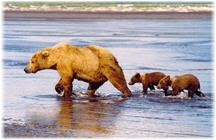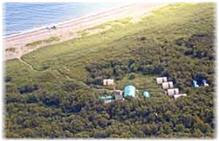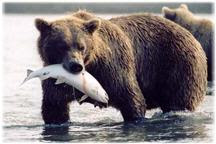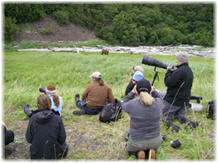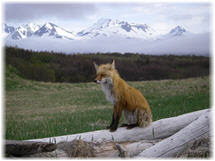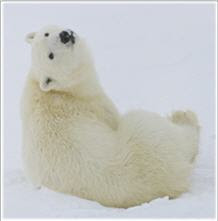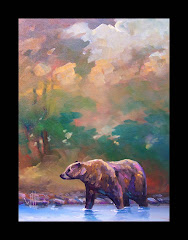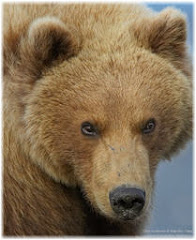River otters in Alaska breed in spring, usually in May.
Mating can take place in or out of the water. One to six
pups (usually two or three) are born the next year any
time from late January to June following a gestation
period of nine to 13 months. Delayed implantation (a
period of arrested embryonic growth) accounts for this
variation in the length of gestation.
The pups are born toothless and blind in a den that is
usually a subterranean burrow. Their eyes open seven weeks
later. When about two months old, they begin to leave the
den and shortly thereafter start to swim and eat solid
food. They are taught to swim by the female who must coax
or drag them into the water. Pups are weaned when about
five months old. They will stay with their mother until
shortly before her next litter is born.
River otters are sexually mature when they are two years
old. A female will then mate with the male of her choice
and produce one litter each year. Otters can live and
breed for more than 20 years.
Wednesday, April 30, 2014
Monday, April 28, 2014
Sunday, April 27, 2014
Sandhill Cranes
Cranes arrive at their nesting grounds in early to
mid-May. They nest on wet tundra, marshes, and muskegs.
Their nests are often simple affairs — shallow depressions
in the soil lined with dry grass and feathers. Normally,
two eggs are laid but anywhere from one to three eggs is
also seen. Eggs are spotted and gray to brown in color,
with both sexes incubating them until they hatch after
about 30 days. Nestlings are able to walk immediately
after hatching. The young are frequently fed food items
caught by the adults but can also capture insects on their
own from an early age. In two to two-and-a-half months,
the young have fledged and are ready to undertake the
southward migration with their parents.
Thursday, April 24, 2014
Wednesday, April 23, 2014
Fun Bird Facts
- Lighthouses are dangerous for birds. The beams attract birds, especially in misty conditions, and many are killed when they fly into the glass.
- Birds sense winter is coming by 1) changes in hormones that cause them to put on fat, 2) the changing length of the day, and 3) sensing small changes in air pressure, which is important in predicting weather changes.
- A group of crows is called a murder or congress. A group of owls is called a parliament, wisdom, or study. A group of flamingos is called a flamboyance.
- The Bald Eagle builds the largest tree nest of all birds, measuring about 9.5 ft. (2.9 m) across. The largest nest ever found was nearly 10 ft. wide and weighed close to 3 tons.
- Woodcocks and many ducks have their eyes placed at the sides of their heads so that they have a 360-degree field of vision.
- A special arrangement of blood vessels cools the blood going out to the feet and warms the blood coming back, so even when standing on the ice, birds don’t lose too much heat.
- Both the Bee and the Vervain Hummingbirds build the smallest nests of all birds, measuring 3/4" across and 1.2" deep.
- The most dangerous bird in the world is the Cassowary. With one kick it can kill its enemy.
- Birds that are raised for meat and eggs (poultry) are the largest source of protein eaten by humans.
- The Fieldfare birds have a special way to attack an enemy bird. They gang up on it and make it fly to the ground. Then the Fieldfares fly into the air and drop poop on the bird.
Sunday, April 20, 2014
Thursday, April 17, 2014
Wednesday, April 16, 2014
Ravens in Alaska
Ravens in the Interior begin displaying courtship
behavior in mid-January, and by mid-March adult pairs are
roosting near their nesting locations. The female lays
from 3 to 7 eggs. Only the female incubates the eggs; she
is fed by the male while on the nest. The chicks hatch
after about three weeks blind, featherless, and helpless:
a characteristic known as altricial. They grow quickly, as
both parents feed the young by regurgitating food and
water which is stored in a throat pouch. About four weeks
after hatching, young are ready to leave the nest, which
is usually around the first week of June in the Interior.
Young remain with parents after fledging.
Ravens reach sexual maturity at 3 or 4 years of age and mate for life. Ravens are probably very long-lived in the wild; one captive bird died of old age at 29 years.
Ravens reach sexual maturity at 3 or 4 years of age and mate for life. Ravens are probably very long-lived in the wild; one captive bird died of old age at 29 years.
Tuesday, April 15, 2014
Wolf Facts
- The Greek god Apollo is sometimes called Apollo Lykios, the wolf-Apollo, and was associated with the wind and sun. In Athens, the land surrounding the temple of Apollo became known as the Lyceum, or the “wolf skin.”
- In 1927, a French policeman was tried for the shooting of a boy he believed was a werewolf. That same year, the last wild wolves in France were killed.
- When Europeans arrived in North America, wolves became the most widely hunted animal in American history and were nearly extinct by the beginning of the twentieth century. The U.S. Federal government even enacted a wolf eradication program in the Western states in 1915.
- Dire wolves (canis dirus) were prehistoric wolves that lived in North America about two million years ago. Now extinct, they hunted prey as large as woolly mammoths.
- A wolf can run about 20 miles (32 km) per hour, and up to 40 miles (56 km) per hour when necessary, but only for a minute or two. They can “dog trot” around 5 miles (8km) per hour and can travel all day at this speed.
- The smallest wolves live in the Middle East, where they may weigh only 30 pounds. The largest wolves inhabit Canada, Alaska, and the Soviet Union, where they can reach 175 pounds.
- Wolves howl to contact separated members of their group, to rally the group before hunting, or to warn rival wolf packs to keep away. Lone wolves will howl to attract mates or just because they are alone. Each wolf howls for only about five seconds, but howls can seem much longer when the entire pack joins in.
- A light-reflecting layer on a wolf’s eye called the tapetum lucidum (Latin for “bright tapestry”) causes a wolf’s eyes to glow in the dark and may also facilitate night vision. While a wolf’s color perception and visual acuity maybe be inferior to a human’s, a wolf’s eyes are extremely sensitive to movement.
- Where there are wolves, there are often ravens (sometimes known as “wolf-birds”). Ravens often follow wolves to grab leftovers from the hunt—and to tease the wolves. They play with the wolves by diving at them and then speeding away or pecking their tails to try to get the wolves to chase them.
- In ancient Rome, barren women attended the Roman festival Lupercalia (named for the legendary nursery cave of Romulus and Remus) in the hopes of becoming fertile.
Monday, April 14, 2014
Sunday, April 13, 2014
Alaska Mythology
A man belonging to the Raven clan living in a very large town had
lost all of his friends, and he felt sad to think that he was left
alone. He began to consider how he could leave that place without
undergoing hardships. First he thought of paddling away, but he said to
himself, "If I paddle away to another village and the people there see
that I am alone, they may think that I have run away from my own
village, on account of some other disgraceful thing." So he thought that he would go off into the forest.
While this man was traveling along in the woods the thought occurred to him to go to the bears and let the bears kill him. The village was at the mouth of a large salmon creek, so he went over to that early in the morning until he found a bear trail and lay down across the end of it. He thought that when the bears came out along this trail they would find and kill him.
By and by, as he lay there, he heard the bushes breaking and saw a large number of grizzly bears coming along. The largest bear led, and the tips of his hairs were white. Then the man became frightened. He did not want to die a hard death and imagined himself being torn to pieces among the bears. So, when the leading bear came up to him, he said to it, "I have come to invite you to a feast." At that the bear's fur stood straight up, and the man thought that it was all over with him, but he spoke again saying, "I have come to invite you to a feast, but, if you are going to kill me, I am willing to die. I am alone. I have lost all of my property, my children, and my wife."
As soon as he had said this the leading bear turned about and whined to the bears that were following. Then he started back and the rest followed him. He imagined that the biggest bear had told his people to go back because they were invited to a feast. When he got home he began to clean up. The old sand around the fireplace he took away and replaced with clean sand. Then he went for a load of wood. When he told the other people in that village, however, they were all very much frightened, and said to him, "What made you do such a thing?" After that the man took off his shirt, and painted himself up, putting stripes of red across his upper arm muscles, a stripe over his heart, and another across the upper part of his chest.
Very early in the morning, after he had thus prepared, he stood outside of the door looking for them. Finally he saw them at the mouth of the creek, coming along with the same big bear in front. When the other village people saw them, however, they were so terrified that they shut themselves in their houses, but he stood still to receive them. Then he brought them into the house and gave them seats, placing the chief in the middle at the rear of the house and the rest around him. First he served them large trays of cranberries preserved in grease. The large bear seemed to say something to his companions, and as soon as he began to eat the rest started. They watched him and did whatever he did. The host followed that up with other kinds of food, and, after they were through, the large bear seemed to talk to him for a very long time. The man thought that he was delivering a speech, for he would look up at the smoke hole every now and then and act as though talking. When he finished he started out and the rest followed. As they went out each in turn licked the paint from their host's arm and breast.
The day after all this happened the smallest bear came back, as it appeared to the man, in human form, and spoke to him in Tlingit. He had been a human being who was captured and adopted by the bears. This person asked the man if he understood their chief, and he said, "No." "He was telling you," the bear replied, "that he is in the same condition as you. He has lost all of his friends. He had heard of you before he saw you. He told you to think of him when you are mourning for your lost ones."
When the man asked this person why he had not told him what was said the day before, he replied that he was not allowed to speak his native language while the chief was around. It was on account of this adventure that the old people, when they killed a grizzly bear, would paint a cross on its skin. Also, when they gave a feast, no matter if a person were their enemy, they would invite him and become friends just as this man did to the bears.
While this man was traveling along in the woods the thought occurred to him to go to the bears and let the bears kill him. The village was at the mouth of a large salmon creek, so he went over to that early in the morning until he found a bear trail and lay down across the end of it. He thought that when the bears came out along this trail they would find and kill him.
By and by, as he lay there, he heard the bushes breaking and saw a large number of grizzly bears coming along. The largest bear led, and the tips of his hairs were white. Then the man became frightened. He did not want to die a hard death and imagined himself being torn to pieces among the bears. So, when the leading bear came up to him, he said to it, "I have come to invite you to a feast." At that the bear's fur stood straight up, and the man thought that it was all over with him, but he spoke again saying, "I have come to invite you to a feast, but, if you are going to kill me, I am willing to die. I am alone. I have lost all of my property, my children, and my wife."
As soon as he had said this the leading bear turned about and whined to the bears that were following. Then he started back and the rest followed him. He imagined that the biggest bear had told his people to go back because they were invited to a feast. When he got home he began to clean up. The old sand around the fireplace he took away and replaced with clean sand. Then he went for a load of wood. When he told the other people in that village, however, they were all very much frightened, and said to him, "What made you do such a thing?" After that the man took off his shirt, and painted himself up, putting stripes of red across his upper arm muscles, a stripe over his heart, and another across the upper part of his chest.
Very early in the morning, after he had thus prepared, he stood outside of the door looking for them. Finally he saw them at the mouth of the creek, coming along with the same big bear in front. When the other village people saw them, however, they were so terrified that they shut themselves in their houses, but he stood still to receive them. Then he brought them into the house and gave them seats, placing the chief in the middle at the rear of the house and the rest around him. First he served them large trays of cranberries preserved in grease. The large bear seemed to say something to his companions, and as soon as he began to eat the rest started. They watched him and did whatever he did. The host followed that up with other kinds of food, and, after they were through, the large bear seemed to talk to him for a very long time. The man thought that he was delivering a speech, for he would look up at the smoke hole every now and then and act as though talking. When he finished he started out and the rest followed. As they went out each in turn licked the paint from their host's arm and breast.
The day after all this happened the smallest bear came back, as it appeared to the man, in human form, and spoke to him in Tlingit. He had been a human being who was captured and adopted by the bears. This person asked the man if he understood their chief, and he said, "No." "He was telling you," the bear replied, "that he is in the same condition as you. He has lost all of his friends. He had heard of you before he saw you. He told you to think of him when you are mourning for your lost ones."
When the man asked this person why he had not told him what was said the day before, he replied that he was not allowed to speak his native language while the chief was around. It was on account of this adventure that the old people, when they killed a grizzly bear, would paint a cross on its skin. Also, when they gave a feast, no matter if a person were their enemy, they would invite him and become friends just as this man did to the bears.
Saturday, April 12, 2014
Friday, April 11, 2014
Fun Bird Facts
- Not all birds have equally hollow bones. Those that dive into water—like gannets, terns, and kingfishers—and those that fly very fast, like swifts, have less air in their long bones than other birds.
- What keeps a bird up in the air is the shape of its wings.The first humans to discover how birds stay aloft were Australian Aborigines when they invented the boomerang.
- The linear flight formations of migratory birds are called echelons, with the most common shapes being the “V” or the “J.” In fact, a true V-shaped formation is less common than a J formation. Birds fly in formation a) because it saves energy and b) to facilitate orientation and communication among the birds.
- An albatross can soar for as long as six hours without moving its wings.
- The heaviest bird in the air is the Kori Bustard, from East and South Africa. It weighs about 31 lb. (14 kg.), with the largest on recorded being 40 lb. (18 kg.). Because it is such hard work to fly, it flies only in emergencies and for only short distances.
- A Ruby-throated Hummingbird, which weighs less than 0.2 oz., has to beat its wings more than 52 times a second to hover in front of a flower.
- The smallest bird in the world is the Bee Hummingbird of Cuba. It is just over 2 in. (5.7 cm.) long, which is not much bigger than a bumblebee.
- The fastest level flight by a bird has been seen in both the Spine-tailed Swift and the Red-breasted Merganser (a duck). They have flown at 100 mph (161 kph) in level flight.
- The slowest flying bird is the American Woodcock. It can fly at just 5 mph (8 kph). When hummingbirds hover, they move at 0 mph. Additionally, hummingbirds are the only birds that can fly backwards under power, registering a negative speed.
- The Rufous hummingbird is the smallest migrant bird. It is less than 4 in. (9 cm) long and flies every year from Alaska to Mexico, a round trip of 3,800 miles (6,400 km).
Thursday, April 10, 2014
DisneyNature 'Bears'
Meet The Cubs
in the Disney Nature Movie
in the Disney Nature Movie
Bears
Filmed in large part at Hallo Bay Bear Camp
Wednesday, April 9, 2014
Sandhill cranes
Sandhill cranes are among Alaska’s largest birds. They are
wading birds that have long black legs, long necks, and black
chisel-shaped bills. Adults stand almost three feet (0.9 m)
tall and have a wing span of six feet (1.8 m) or more. Mature
birds are an ash-gray color with a bright red forehead.
Immature birds are quite mottled with coppery or rusty
feathers and lack the red forehead of adults. Adult plumage is
attained at two-and-a-half years. In the past, the sandhill
cranes in Alaska were called “little brown” cranes and were
thought to be a separate species based on their color.
Tuesday, April 8, 2014
Monday, April 7, 2014
Alaska Wolf
Typically one female wolf in a pack has a litter of about seven pups each year. This varies, in some packs more than one female may bring off a litter.
In some cases a pair of wolves may not form a pack or belong to a pack, and will bring off a litter of pups.
Alaska is home to an estimated 7,000 to 11,000
wolves.
- Other names
Grey wolf, timber wolf.
Sunday, April 6, 2014
Bear Mythology
A man belonging to the Te'qoedî went hunting on Unuk (Djû'nAx)
river, and came to a bear's den. While he was examining it the male
bear threw him inside. Then the bear's wife dug a hole in the ground and
concealed him there. When the male bear came in he said, "Where is that
man that I threw in here?" "I haven't seen anyone. You haven't thrown
anybody in here." "I did. I threw a man in here." The male bear became
angry at her denials and left her, upon which the man married this bear
and had children by her, although he had a family at home.
Meanwhile the man's four brothers looked for him continually, keeping away from their wives so as to find him, but in vain. They could see his tracks in the snow, but they could not discover where they led to. They suspected the truth, because other hunters had also been captured there by animals, and the shamans told them that this had happened to him. As soon as they left the town with their dogs, however, the she-bear could feel it and made them pass by.
But the youngest boy had not searched. Finally he started off too, and the bear felt that he was coming, but she found that she could not make him turn aside and said to her husband, "Well! we are caught." The dogs scented him, and, when he looked out, there was his own dog barking. He called to it by its name, Man-for-the-mountains (Câ'yîs!-xwa). Then his brother knew what was the matter and came to the mouth of the den with his spears, determined to bring back his brother alive or dead. When the man saw his youngest brother outside he said, "Stand right there. Don't do any harm. I am here. Although I am with this wild animal, I am living well. Don't worry about me any more."
When he was first taken into this den it looked like a den and nothing more, but that night he thought that he was in a fine house with people all about eating supper, and his wife looked to him like a human being.
In May, when the bears were about to leave their dens, his wife said, "Now you can go to your village. Take good care of your little ones. Don't go near your wife. Don't look toward her even." So he went to the place where his brothers were living and said, "Tell my wife not to come near me for a while. She must have pity on me. Ask her to stay away." Then he began to go off hunting. He had luck from his bear wife, and killing seals was nothing to him. One day, while he was out, he saw some bear cubs coming toward him and presently found that they were his little ones. Then he gave them all the seals he had killed. He fed them every day. When his younger brother went hunting with him and the cubs came running toward the canoe, he would say, "Don't be frightened. Those are your children" (meaning" your brother's children").
By and by his human wife came to him. She was angry with him and said, "Why do your children starve on my hands? What are you doing feeding cubs instead of my little ones?" After that, though he did not dare to say a word to his wife, he began feeding her children. He thought, "I wonder what will happen to me now for feeding the little ones."
Presently he went hunting again and again took some seals to his cubs. As he was going toward them he noticed that they did not act the same as usual. They lay flat on the ground with their ears erect. Then he landed, but, when he got near them, they killed him. It is on account of this story that the Te'qoedî claim the grizzly bear.
Meanwhile the man's four brothers looked for him continually, keeping away from their wives so as to find him, but in vain. They could see his tracks in the snow, but they could not discover where they led to. They suspected the truth, because other hunters had also been captured there by animals, and the shamans told them that this had happened to him. As soon as they left the town with their dogs, however, the she-bear could feel it and made them pass by.
But the youngest boy had not searched. Finally he started off too, and the bear felt that he was coming, but she found that she could not make him turn aside and said to her husband, "Well! we are caught." The dogs scented him, and, when he looked out, there was his own dog barking. He called to it by its name, Man-for-the-mountains (Câ'yîs!-xwa). Then his brother knew what was the matter and came to the mouth of the den with his spears, determined to bring back his brother alive or dead. When the man saw his youngest brother outside he said, "Stand right there. Don't do any harm. I am here. Although I am with this wild animal, I am living well. Don't worry about me any more."
When he was first taken into this den it looked like a den and nothing more, but that night he thought that he was in a fine house with people all about eating supper, and his wife looked to him like a human being.
In May, when the bears were about to leave their dens, his wife said, "Now you can go to your village. Take good care of your little ones. Don't go near your wife. Don't look toward her even." So he went to the place where his brothers were living and said, "Tell my wife not to come near me for a while. She must have pity on me. Ask her to stay away." Then he began to go off hunting. He had luck from his bear wife, and killing seals was nothing to him. One day, while he was out, he saw some bear cubs coming toward him and presently found that they were his little ones. Then he gave them all the seals he had killed. He fed them every day. When his younger brother went hunting with him and the cubs came running toward the canoe, he would say, "Don't be frightened. Those are your children" (meaning" your brother's children").
By and by his human wife came to him. She was angry with him and said, "Why do your children starve on my hands? What are you doing feeding cubs instead of my little ones?" After that, though he did not dare to say a word to his wife, he began feeding her children. He thought, "I wonder what will happen to me now for feeding the little ones."
Presently he went hunting again and again took some seals to his cubs. As he was going toward them he noticed that they did not act the same as usual. They lay flat on the ground with their ears erect. Then he landed, but, when he got near them, they killed him. It is on account of this story that the Te'qoedî claim the grizzly bear.
Saturday, April 5, 2014
Bear Facts
- A newly born Kodiak brown bear can weigh less than one pound. As it grows up, its weight may increase as much as 1,000 times. If human babies grew this much, as adults they would weigh over 6,000 lbs.
- Polar bears have the largest home ranges of any bear. One polar bear can hunt and live in an area as big as Maine.
- Stone-age hunters worshipped and hunted bears at the same time. To show their respect, they sang and danced and prayed that the bear would forgive them for killing it.
- In Asia, bear cubs are often taken from their mothers at an early age to be trained as dancing bears. The ability of bears to stand up on their hind feet makes it possible for them to shuffle in a way that looks somewhat like dancing.
- People in Asian cultures have traditionally used bear organs and secretions for medicinal purposes. One author notes that there “are fewer than one million bears on Earth and more than one billion potential consumers of bear parts as medicine.”
- In Asia in the early 1990s, bear gallbladders would sell from $1 to $210 a gram. A gallbladder of an Asiatic black bear killed in South Korea sold at a public auction for $64,000. On a price-per-gram basis, bear gallbladders often cost more than gold.
- Currently, approximately 8,000 bears are kept on “bear farms” in China. They are bred and kept in captivity so that bile from the gallbladders can be extracted for medicinal use. The bile is removed from the live animal through a catheter surgically implanted into the gallbladder.
- All bears are good swimmers, but the polar bear is the most efficient swimmer. It can swim up to 4-6 mph (6-10 km/hr) for 100 miles (161 km). One polar bear swam 200 miles without stopping. Polar bears can also swim very well under water.
- The only species of bear that does not move its ears to pick up sound is the giant panda.
- The Asiatic black bear has the largest ears of any species of bears.
Thursday, April 3, 2014
Wednesday, April 2, 2014
Harbor Seal
Harbor seals are well adapted to life in the sea. They
are able to dive to depths up to 1640 feet (500m) and can
remain submerged for over 20 minutes, although most dives
are less than 65ft (20m) and less than 4 minutes long.
Oxygen-conserving adaptations that allow such dives
include high blood volume, reduced peripheral circulation,
reduced heart rate, and high levels of myoglobin
(oxygen-binding protein in muscle).
Harbor seals haul out of the water periodically to rest, give birth, and nurse their pups. In winter seals spend up to 80% of their time in the water. In spring and summer they spend more time hauled out during pupping and molt season. Harbor seals molt annually, usually in summer; timing of molt depends upon sex and age class.
Harbor seals haul out of the water periodically to rest, give birth, and nurse their pups. In winter seals spend up to 80% of their time in the water. In spring and summer they spend more time hauled out during pupping and molt season. Harbor seals molt annually, usually in summer; timing of molt depends upon sex and age class.
Tuesday, April 1, 2014
Katmai Lynx
Lynx normally travel one to five miles per day within
home ranges ranging from five to more than 100 square
miles. The largest ranges occur when prey are scarce. Lynx
travel and hunt at a walk most of the time and capture
their prey with short bursts of speed. They often ambush
hares and other small prey while bedded down near small
game trails. Lynx are adept at climbing trees but hunt
mainly on the ground, sometimes using trees as a refuge
from larger predators such as wolves.
Subscribe to:
Comments (Atom)

.jpg)
.jpg)
.jpg)
.jpg)
.jpg)
.jpg)
.jpg)
.jpg)
.JPG)
.JPG)
.JPG)
.jpg)
.jpg)
.jpg)
.jpg)
.jpg)
.jpg)
.jpg)
.jpg)
.jpg)
.jpg)
.jpg)
.jpg)
.jpg)
.JPG)
.JPG)
.jpg)
.jpg)
.jpg)
.JPG)

.jpg)




 Alaska Time
Alaska Time